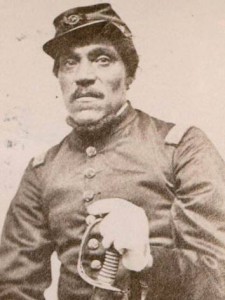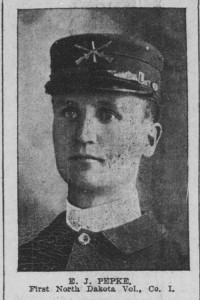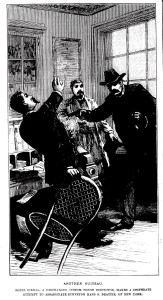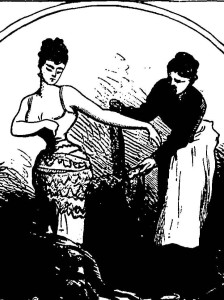 Only July 18, 1863, Sergeant Peter Vogelsang was shot through the lungs during the assault on Fort Wagner. A member of New York’s African-American elite, he had enlisted in the Union Army at the ripe age of forty-six. (more…)
Only July 18, 1863, Sergeant Peter Vogelsang was shot through the lungs during the assault on Fort Wagner. A member of New York’s African-American elite, he had enlisted in the Union Army at the ripe age of forty-six. (more…)
Emil J. Pepke, Accused
 I love finding a portrait of a character. Here’s Emil J. Pepke, a discharged North Dakota infantryman accused in 1900 of smuggling fourteen diamond rings from the Philippines into the U.S. He took his case to the Supreme Court, which used it to define the legal status of territories conquered in 1898. Pepke won his suit, but never got his rings back, as they had already been sold by customs officials.
I love finding a portrait of a character. Here’s Emil J. Pepke, a discharged North Dakota infantryman accused in 1900 of smuggling fourteen diamond rings from the Philippines into the U.S. He took his case to the Supreme Court, which used it to define the legal status of territories conquered in 1898. Pepke won his suit, but never got his rings back, as they had already been sold by customs officials.
Rose Eytinge, Actress and Contrabandist
 This is Rose Eytinge, a 19th-century actress and contrabandist. Her many friends and lovers—including married NYT editor Henry J. Raymond, who died in her arms—kept her from ever being arrested.
This is Rose Eytinge, a 19th-century actress and contrabandist. Her many friends and lovers—including married NYT editor Henry J. Raymond, who died in her arms—kept her from ever being arrested.
Inspector Profile: Lewis Bieral
 On November 1, 1886, Louis Bieral, a.k.a. Lewis Clark, walked into the office of Hans Beattie, Surveyor of the Port of New York, and fired two pistol shots at his former boss. Beattie survived, but he was never the same. (more…)
On November 1, 1886, Louis Bieral, a.k.a. Lewis Clark, walked into the office of Hans Beattie, Surveyor of the Port of New York, and fired two pistol shots at his former boss. Beattie survived, but he was never the same. (more…)
Women Smugglers of the Gilded-Age
 Gilded-age American newspapers commonly printed drawings of female customs inspectors undressing young women looking for contraband. They published them partly to titillate (more…)
Gilded-age American newspapers commonly printed drawings of female customs inspectors undressing young women looking for contraband. They published them partly to titillate (more…)
Smuggling and Citizenship
I wrote a guest post for Religion in American History:
The nineteenth-century United States was a paradoxical place for Jews. No land on Earth was more open to Jewish immigration. The First Amendment to the Constitution and the disestablishment of state religions meant non-Christians could be citizens and office holders. Yet, Jews were a tiny minority. If discrimination was less common in the U.S. than in nations like Russia, it was nonetheless a reality that democratic ideology could not staunch.